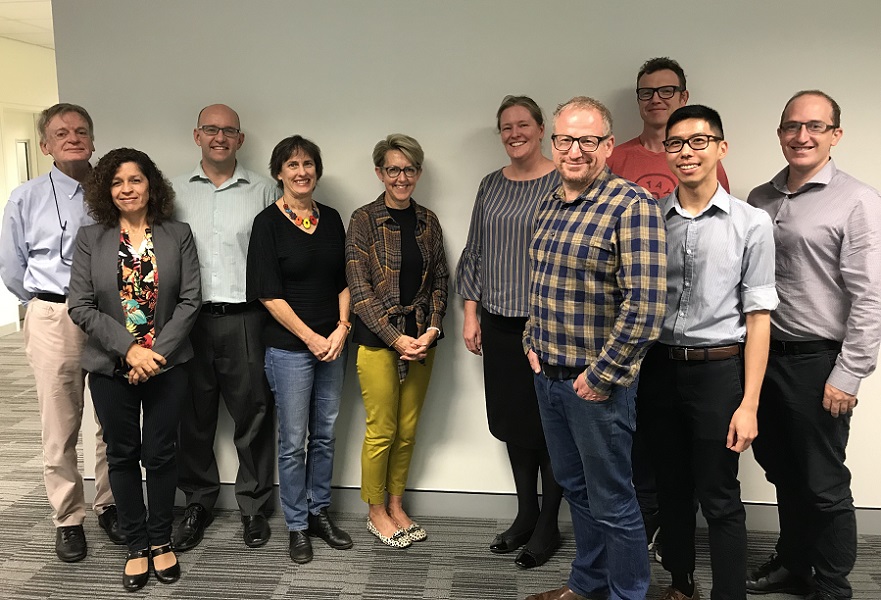Less can be more: Researching non-beneficial treatment at the end-of-life
A blog post written by Professor Adrian Barnett, Chief Investigator, InterACT Study and Professor of Statistics, Australian Centre for Health Services Innovation (AusHSI), Queensland University of Technology
 |
|
InterACT investigator team (L to R): Professor Ken Hillman, A/Prof Magnolia Cardona, Professor Ben White, Professor Lindy Willmott, Professor Gillian Harvey, Professor Leonie Callaway, Professor Nick Graves, Professor Adrian Barnett, Dr Xing Lee, Professor Steve McPhail
|
The National Health and Medical Research Council (NHMRC) has funded a study designed to increase awareness among hospital clinicians of the extent of non-beneficial treatment at the end-of-life and stimulate action to reduce it. This study is led by the Australian Centre for Health Services Innovation (AusHSI) and the Australian Centre for Health Law Research (ACHLR) from Queensland University of Technology (QUT). Ten academic investigators and four partner institutions will work together on the three-year project, called the InterACT study: Intervention for Appropriate Care and Treatment.
Advances in medicine mean health care professionals can prolong life, yet some treatments: have a low chance of providing tangible benefits to some patients, can result in a ‘bad death’, and represent a multi-million dollar cost to the public purse. [1] This project builds on a previous collaboration between QUT health researchers and law Professors Lindy Willmott and Ben White where they, with researchers from the University of Queensland, identified reasons why doctors sometimes provide treatment they know to be futile. [2]
In 2016, a systematic review of 38 international studies found 33% to 38% of older patients in their last hospitalisation received non-beneficial treatment at the end-of-life. [3]
A 2017 study of three Australian hospitals measured: incidences of futile treatment among end-of-life admissions; length of stay in both ward and intensive care settings for the duration that patients received futile treatments; health system costs associated with those treatments and the monetary value of bed days involved. This research found the incidence rate of futile treatment in end-of-life admissions was 12% across the three study hospitals, with a mean duration of non-beneficial treatment of 15 days. The cost associated with futile bed days was estimated to be $12 million using health system costs, and $988,000 when using a decision maker’s willingness to pay for bed days. This was extrapolated to an annual national health system cost of $153 million. [4]
Beyond these health costs there are significant patient, family and clinician impacts associated with receiving and delivering non-beneficial treatments at the end-of-life.
Our new partnership seeks to reduce the provision of futile or non-beneficial treatment and promote appropriate care and treatment pathways for elderly patients in acute hospitals at the end-of-life.
The InterACT study will use a stepped-wedge randomised-controlled study design to assess the implementation, impact and cost-consequences of a prospective feedback loop intervention with clinical teams in three South-East Queensland hospitals. It is anticipated that we will improve the capacity of clinicians to choose alternative treatments and increase institutional support for better end-of-life care for a group of vulnerable patients.
Project partners are the Deeble Institute for Health Policy Research, Australian Healthcare and Hospitals Association (AHHA), Palliative Care Australia, Metro North Hospital and Health Service and the Gold Coast Hospital and Health Service. The connections made with health services and policy groups by this partnership will improve the likelihood of changing practice.
The trial component of the InterACT study will run from November 2019 to February 2021. Participating hospitals are the Royal Brisbane and Women’s Hospital, the Prince Charles Hospital and the Gold Coast University Hospital. For more information please contact Alison Farrington, Research Project Manager, alison.farrington@qut.edu.au.
References
- White B, Willmott L, Close E, Shepherd N, Gallois C, Parker MH, et al. What does "futility" mean? An empirical study of doctors' perceptions. Med J Aust. 2016 May;204(8):318
- Willmott L, White B, Gallois C, Parker M, Graves N, Winch S, et al. Reasons doctors provide futile treatment at the end of life: a qualitative study. J Med Ethics. 2016 Aug;42(8):496-503. doi: 10.1136/medethics-2016-103370. Epub 2016 May 17
- Cardona-Morrell M, Kim JCH, Turner RM, Anstey M, Mitchell IA, Hillman K. Non-beneficial treatments in hospital at the end of life: A systematic review on extent of the problem. Int J Qual Health Care. 2016 Sep;28(4):456-69. doi: 10.1093/intqhc/mzw060. Epub 2016 Jun 27.
- Carter HE, Winch S, Barnett AG, Parker M, Gallois C, Willmott L, et al. Incidence, duration and cost of futile treatment in end-of-life hospital admissions to three Australian public-sector tertiary hospitals: a retrospective multicentre cohort study. BMJ Open. 2017;7(10):e017661. doi: 10.1136/bmjopen-2017-017661.
Find more research on decision making at the end of life by visiting the CareSearch Systematic Review Collection.